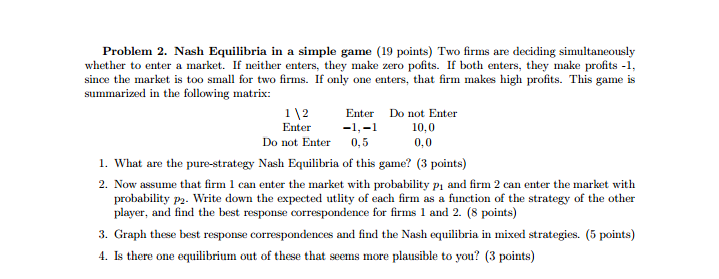
Help me with the following
Problem 1. Monopoly, Oligopoly, and Perfect Competition (46 points) In this problem you are asked to compare the outcomes of monopoly, oligopoly, and perfect competition in one market. We are going to assume very simple functional forms in order to simplify the algebra. We assume that the firm has a very simple cost function: c(y) = cy, with c > 0. The marginal cost of production therefore is constant. As for the market demand, we assume that it takes the simple linear form p (Y) = a - bY, with a > c > 0 and 6 >0, where Y is the total production on the industry. 1. Consider first the case of perfect competition. Derive the marginal and average cost curves. How does the supply curve look like for each firm? What about in the industry? (aggregate the individual supply curve over / firms). (4 points) 2. Equate supply and demand to obtain the industry-level production under perfect competition Yfc, as well as the price level under perfect competition ppc. (3 points) 3. How do perfect competition price and quantity vary as the cost of production c increases? How do they vary if there is a positive demand shock (a increases)? (3 points) 4. We consider now the monopoly case. Write down the profit maximization problem and the first order conditions with respect to y. [In the case of monopoly, y = Y'] (2 points) 5. Solve for yy and pyr- How does py vary as a increases? Why is this comparative statics different from the one under perfect competition? (2 points) 6. Compare the total output and prices of perfect competition and monopoly. Compute the monopoly profits and compare them to the profits under perfect competition. (3 points) 7. Consider now the case of duopoly, that is, an oligopoly with two firms, i = 1, 2. Write down the profit maximization problem of firm i as a function of the quantity produced by firm -i, y-i. (3 points) 8. We are now looking for Nash equilibria (in pure strategies) in the quantity produced 31, 32. Each firm i, holding fixed the qantity produce by the other firm at y;, maximizes profits with respect to y;. Write down the first order conditions for firms 1 and 2. (3 points) 9. In a Nash equilibrium each firm must choose the optimal quantity produced given the production choice of the other firm. Combine the two first order conditions in point 5 to obtain the Nash equilibrium quantity produced by firm 1, yj, and by firm 2, y;- Derive also the industry production Y; = y; + 1;, the price pp, the profit level of each firm #1,p, and the aggregate profit level Ilp = sip + Tip (6 points) 10. Compare Yb, IIp, and p; with Vac IIpc, and pec and Yy Ily, and pyr. (3 points) 11. Finally, the general case of oligopoly. Assume that there are I firms, all identical, with production costs as above. Write down the profit maximization problem and the first order condition of a firm. (2 points) 12. We now solve for the oligopoly production using a trick. We look for a symmetric solution, that is, a solution where each firm produces the same. In particular, impose the condition }; == );y; = (I - 1) yo. Find the solution for the Nash equilibrium quantity yo- Derive also the industry production Y6 = Iyb, the price po, the profit level of each firm ab, and the aggregate profit level II; = Ing. (4 points) 13. What is nice about this general oligopoly solution is that embeds the previous cases: for I = 1 we go back to monopoly, for I = 2 we get the duopoly solution. Most interestingly, show that for I - co, the prices, the total quantity produced, and the total industry profits converge to the perfect competition ones. Compare this to Bertrand competition. How many companies did we need there to get the same outcomes as perfect competition? (8 points)Problem 2. Nash Equilibria in a simple game (19 points) Two firms are deciding simultaneously whether to enter a market. If neither enters, they make zero pofits. If both enters, they make profits -1, since the market is too small for two firms. If only one enters, that firm makes high profits. This game is summarized in the following matrix: 1 \\2 Enter Do not Enter Enter -1, -1 10.0 Do not Enter 0,5 0.0 1. What are the pure-strategy Nash Equilibria of this game? (3 points) 2. Now assume that firm I can enter the market with probability p, and firm 2 can enter the market with probability p2. Write down the expected utlity of each firm as a function of the strategy of the other player, and find the best response correspondence for firms 1 and 2. (8 points) 3. Graph these best response correspondences and find the Nash equilibria in mixed strategies. (5 points) 4. Is there one equilibrium out of these that seems more plausible to you? (3 points)









